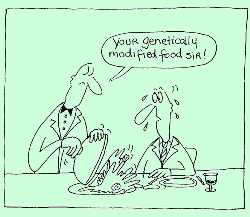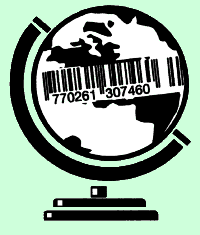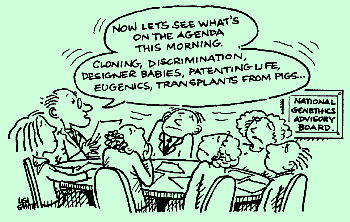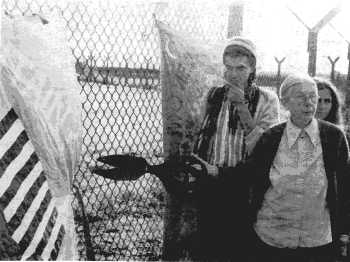A 1 Introduction to the
Campaign
A 1.1 The effects and implications
of genetically modified plants
"History celebrates the battlefields whereon we
meet our death, but scorns to speak of the ploughed fields
whereby we thrive; it knows the names of king's bastards, but
cannot tell us the origin of wheat. That is the way of human
folly."
Jean Henri Fabre |
This appendix gives a brief introduction to the genetic
modification of food crops. For further information please refer
to the reading list at the end of this appendix.
A1.1.1 The unpredictable effects of
genetic modification
The proponents of genetic modification of food crops claim that
it is safe, more precise and a natural extension of traditional
cross-breeding methods and that all they are doing is giving
nature a helping hand.
 This is
not the case - genetic engineering permits the transfer of genes
between totally unrelated organisms, circumventing natural
species barriers e.g. the introduction of a fish gene, the
"antifreeze" gene of the arctic flounder, into tomatoes and
strawberries. This crossing of species barriers is something that
would never happen by traditional breeding methods.
This is
not the case - genetic engineering permits the transfer of genes
between totally unrelated organisms, circumventing natural
species barriers e.g. the introduction of a fish gene, the
"antifreeze" gene of the arctic flounder, into tomatoes and
strawberries. This crossing of species barriers is something that
would never happen by traditional breeding methods.
The method of introduction of the new gene is not at all precise.
The new gene is randomly incorporated (spliced) into the plant's
own DNA, it could end up anywhere, next to any gene or even
within one of the plant's own genes. Genes do not work in
isolation and the activity of each gene is affected by its
neighbours. The random splicing of the new gene into the plant
may then cause a totally unpredictable disturbance to the normal
function and regulation of the plant's own genes. For example in
an experiment to turn white flowering petunias red, a gene for
the colour red, together with an antibiotic resistance gene, was
transferred from maize to the petunia. The petunia turned red but
also grew more leaves and shoots, had lower fertility and was
more resistant to fungi. None of these additional effects was
predictable. Further the introduced gene may not work in the same
way in its new host. The antifreeze gene in the arctic flounder
has evolved to work with the other genes in that fish - there is
no way to predict whether it will work in exactly the same way
with no unwanted side effects in the tomato or strawberry where
it will be in a new environment surrounded by the plant's
genes.
 There are
many unanswered questions about the basic science behind the
technology of genetic engineering and many believe that until we
have answers to these questions genetic engineering should be
kept in the laboratory. Others, principally the biotechnology
companies and the government are anxious to push the technology
forward before these questions are answered, paying no heed to
the fact that once released into the environment, genetic
mistakes cannot be recalled, cleaned up or allowed to decay but
will be passed on to future generations indefinitely.
There are
many unanswered questions about the basic science behind the
technology of genetic engineering and many believe that until we
have answers to these questions genetic engineering should be
kept in the laboratory. Others, principally the biotechnology
companies and the government are anxious to push the technology
forward before these questions are answered, paying no heed to
the fact that once released into the environment, genetic
mistakes cannot be recalled, cleaned up or allowed to decay but
will be passed on to future generations indefinitely.
"What makes genetic engineering biotechnology
dangerous, in the first instance, is that it is an unprecedented,
close alliance between two great powers that can make or break
the world; science and commerce." Dr Mae-Wan Ho,
geneticist
A1.1.2 Risks of genetically modified
foods to human health
Although there has so far been limited exposure of humans to GM
foods there is already evidence of risks to human health.
A1.1.2.1 Toxic and allergenic
effects
Due to the unpredictable pattern of gene expression and function
there is the potential for the production of unexpected proteins
and novel toxins in GM food crops.
For example, when a gene from the brazil nut was introduced into
the soybean, people allergic to brazil nuts were also found to be
allergic to the GM soya. Fortunately allergies to brazil nut
proteins were well known and were tested for leading to the swift
withdrawal of the GM soya. It is however possible that unknown
allergens could be developed unintentionally in GM foods as tests
for allergenicity are targeted at known allergens and are not
designed to reveal new allergens. Food allergies are increasing,
the development of GM foods with the potential for the presence
of novel proteins will only exacerbate the problem.
In 1989 there was an epidemic of a new disease, eosinophilia
myalgia syndrome. The disease was traced to the consumption of a
food supplement derived from bacteria genetically engineered to
overproduce the aminoacid, L-tryptophan. The excessive amounts of
L-tryptophan in the bacterial cells led to the formation of a
novel toxin, which contaminated the final product. Of 5,000
people who contracted the disease, 37 died and 1,500 are
permanently disabled.
A GM yeast engineered for better fermentation of beer and bread
was found to have abnormally high levels of a metabolite, methyl
glyoxal, a chemical known to cause damage to DNA. The scientists
who carried out this work believe that the risk assessments
required by the present regulatory system, which are based on the
principle of substantial equivalence (i.e. that the new food,
even though it is GM, is substantially the same as foods already
available for consumption), would not have required testing for
the DNA damaging chemical, even though it has the potential to
cause cancers.
"The unexpected production of toxic substances has now
been observed in genetically engineered bacteria, yeast, plants,
and animals with the problem remaining undetected until a major
health hazard has arisen. Moreover, genetically engineered foods
may produce an immediate effect or it could take years for full
toxicity to come to light."
Dr Michael Antoniou MA,PhD. Senior Lecturer in Molecular
Pathology, London.
A1.1.2.2 New and more virulent
viruses
Genetic modification of food crops involves the transfer of a
foreign gene into the host plant cell by a carrier, known as a
vector, such as a virus or bacteria. While natural vectors
generally respect species barriers, the artificial vectors made
by genetic engineers are designed to break through these
barriers, thus greatly enhancing the potential for creating new
and possibly more virulent viral and bacterial pathogens which
can in turn infect humans and animals.
A1.1.2.3 Resistance to
antibiotics
As the process for adding new genes to host plant cells is
random, genetic engineers add "marker" genes at the same time so
that they can tell which plant cells have been genetically
modified. The commonest marker gene used is an antibiotic
resistance gene. Instead of removing the gene after the research
stage the scientists have left it in the host plant cells and a
number of GM crops currently on trial contain the antibiotic
resistance gene. There is growing concern that the use of
antibiotic resistance marker genes in GM crops will exacerbate
the already serious problem of antibiotic resistant infectious
disease, for example by the spread of antibiotic resistance to
human and animal gut microorganisms after eating GM crops.
A1.1.3 Risks to the environment and
the effect on biodiversity
A1.1.3.1 Increasing use of
pesticides
The main focus of the biotechnology companies so far has been on
the creation of crops resistant to herbicides, particularly
glyphosate (e.g. Monsanto's Round-up Ready Soya) and glufosinate
(e.g. AgrEvo's glufosinate resistant oil seed rape). This
approach is flawed at a fundamental level as the production of
herbicide resistant GM crops encourages farmers to look upon the
use of herbicides as the first choice for weed control, rather
than as one of a number of options. Monsanto has applied in
several countries for a relaxation in environmental legislation
to allow a 200 fold increase in glyphosate residues in soya, an
indication that Monsanto acknowledge, contrary to their recent
advertising campaign, that the use of GM crops will increase
herbicide usage. Increased use of herbicides will mean not only
higher residues in food but also serious losses of weeds within
crops, around field edges and in hedgerows, all very important
food sources for wildlife. The Royal Society for the Protection
of Birds, together with other conservation bodies, is calling for
a moratorium on commercial growing of GM herbicide tolerant crops
because of their concerns about the effects of increased
herbicide usage on food sources for birds.
A1.1.3.2 Gene pollution and super
weeds
 Genes
move between plants by cross-pollination - a process known as
horizontal gene transfer. GM oil seed rape has been shown to
cross-pollinate with ordinary oil seed rape growing 2.5 km away
from the GM crop. It is highly likely then, that when GM oil seed
rape is planted on a large scale all oil seed rape will rapidly
become contaminated with the modified genes. Organic standards do
not allow GM materials in organic produce and so farmers will be
unable to grow organic oil seed rape. Oil seed rape, including GM
oil seed rape, also cross-pollinates very easily with wild
relatives such as wild turnip and wild radish. These wild
relatives will become herbicide resistant where they cross-
pollinate with GM oil seed rape with a herbicide resistance gene,
creating "super weeds".
Genes
move between plants by cross-pollination - a process known as
horizontal gene transfer. GM oil seed rape has been shown to
cross-pollinate with ordinary oil seed rape growing 2.5 km away
from the GM crop. It is highly likely then, that when GM oil seed
rape is planted on a large scale all oil seed rape will rapidly
become contaminated with the modified genes. Organic standards do
not allow GM materials in organic produce and so farmers will be
unable to grow organic oil seed rape. Oil seed rape, including GM
oil seed rape, also cross-pollinates very easily with wild
relatives such as wild turnip and wild radish. These wild
relatives will become herbicide resistant where they cross-
pollinate with GM oil seed rape with a herbicide resistance gene,
creating "super weeds".
A1.1.3.3 Plants with built-in
insecticide
Some crops have been designed to be resistant to pests by the
incorporation of genes which produce proteins which are toxic to
insects. For example Novartis have produced a GM maize plant with
genes for the production of Bt toxin. Bt toxin is a very
effective bio-pesticide used by organic farmers on a "one-off"
basis to kill insect pests. In GM crops with the Bt gene, the
gene is never switched off and so the plant produces low levels
of Bt continuously. This is a very effective way to put an
adaptive pressure on the insect pests to become resistant to Bt,
thereby creating "super bugs" and removing from organic farmers
the use of a very effective pesticide. In addition, the newly
incorporated toxins may be harmful to beneficial insects either
directly or indirectly. For example, green lacewings, beneficial
predators that fed on cornborers which had in turn fed on
Novartis' Bt maize, showed increased mortality when compared to
cornborers that had fed on conventional maize. Trials for GM
potatoes modified with a gene from snowdrops which produced a
toxin against greenflies were stopped when it was found that when
the poisoned greenflies were fed to beneficial ladybirds: the
female ladybirds laid up to 30 per cent less eggs than usual and
died after only half of their normal life expectancy.
A1.1.3.4 Bees and polluted
honey
Honey bees are the primary pollinators of oil seed rape and it is
likely that honey from a hive close to a GM oil seed rape field
will contain large amounts of GM pollen. This GM pollen may
introduce into the honey as yet unknown proteins that could have
toxic or allergenic effects on humans and bees. Beekeepers
producing honey from a hive close to a GM crop field will not be
able to claim that their honey is organic because of the high
risk that it will contain GM pollen. It has been shown that bees
feeding on GM pest resistant crops have their life-span
reduced.
A1.1.3.5 Soil bacteria and
horizontal gene transfer
Natural transformation, the ability of bacteria to actively take
up free DNA, is a method by which plant DNA can be transferred to
bacteria. Around 40 species of bacteria, some of which are soil
or water borne, are known to have the ability for natural
transformation. It has been shown in scientific experiments that
horizontal gene transfer from GM plants (in that case GM
sugarbeet) to bacteria can occur. It is likely then that gene
pollution will spread for many miles around GM crop fields,
carried by soil and water borne bacteria.
A1.1.4 Food security and
hunger
"Ironically while the poor go hungry, it is the hunger of
the poor which is used to justify the agricultural strategies
which deepen their hunger" Vandana Shiva
Proponents of genetic modification argue that it will allow us to
feed the world's hungry. This is not only misleading but also
ignores some of the disastrous effects which may arise from
widespread reliance on GM. Malnutrition and hunger are caused by
complex political and economic factors around access to food: GM
is more likely to exacerbate these than alleviate them. The
introduction of GM crop monocultures, with their genetic
uniformity are vulnerable to pests and disease outbreaks:
genetically diverse crops contain a proportion of plants that are
likely to have some degree of resistance. Many countries'
agricultural systems recognise this and already possess the
genetic resources to guarantee a sustainable food supply.
The actual types of food being grown by the biotechnology
companies demonstrate that increasing food availability is not
high on their agenda. Most of the food products from transgenic
crops have been marketed to consumers in affluent industrialised
countries, eg, Monsanto's high-starch 'quick fry' potato for the
fast food market. These crops rarely fit in with traditional
local diets or the plans of local farmers. GM applications are
also spreading the cultivation of non-food crops such as cotton
or tobacco. More of these will not increase food availability or
alleviate starvation in the Third World.
The technological shifts which biotechnology implies will further
bring economic losses and resultant food insecurity for many
Third World countries as agricultural production is transferred
into laboratories and factories in the industrialised world. The
story of vanilla demonstrates this. Vanilla is a major export
crop for Madagascar, the Comoro Islands and Reunion which between
them account for over 98% of the world's vanilla production. In
Madagascar, over 70 000 small holders are involved in the growing
of vanilla and the crop accounts for 10% of the country's export
earnings. This trade is threatened, as vanilla can now be
produced by taking plant tissue and growing it under tissue
culture conditions. Ultimately, food insecurity and hunger will
not be solved by gene technology whilst structural, cultural and
political factors around food production and distribution remain
unresolved.
A1.1.5 Patents and
biopiracy
Current forecasts suggest that in less than two years' time the
market for genetically modified foods in the UK alone will be
worth around £9billion. In the area of food production, the main
profits for biotechnology companies are generated from the sale
of patented GM seed.
 Undermining autonomy
Undermining autonomy
Traditional farming practices involve farmers retaining seeds
from the harvest of one year's crop for planting in the following
year. However, with GM seed, farmers have to make substantial
royalty payments to multinational companies if they keep seed for
replanting, even if the crop happens to be native to their
particular country. This sytem of patents undermines the autonomy
of Third World farmers whilst imposing monopoly control over some
of the world's most important food crops.
From common to corporate ownership
Patent legislation could severely restrict the traditional uses
of plants in the Third World. The neem tree, for example, has
been used for centuries in India as a source of insecticide,
providing an economically and environmentally friendly form of
crop protection. Chemical companies in theUSA have taken out a
series of patents on neem based products effectively taking
ownership out of the common sphere and into the corporate.
Biopiracy
The world's poorest nations account for around 95.7% of the
world's genetic resources. Many of the biotech 'inventions' which
patents claim are not inventions at all but are based on locally
developed biodiversity and knowledge. This biopiracy has been
compared to colonialism, "Corporations continue to practice the
colonialism on which they were founded. This time it is directed,
not at distant countries, but at life itself. They have found
rich new worlds to raid: the genetic wealth of diverse species,
the work of farmers and indigenous people and the intellectual
wealth that they have accumulated and handed down over millenia"
Helena Paul. Ismail Serageldin, chairman of the Consultative
Group on International Agricultural Research, speaking at the
World Food Summit in November 1996, feared that biotechnology
patents, largely owned by industrialised nations, could create a
'scientific apartheid' which locks 80% of people in the
developing world out of scientific advances.
A1.1.6 Ethics and
morals
Stephen Nottingham's book 'Eat Your Genes' identifies three key
issues around the ethics and morality of GM foods. These are (i)
ethical concerns about the transfer of particular genes (ii)
whether genetic modification increases the suffering of animals
and (iii) whether life can be owned.
 The
first of these raises questions around the transfer of human
genes to animals raised as food; the transfer of genes from
animals whose flesh is forbidden to certain religious groups to
animals that are permitted as food;and the transfer of animal
genes to crop plants.
The
first of these raises questions around the transfer of human
genes to animals raised as food; the transfer of genes from
animals whose flesh is forbidden to certain religious groups to
animals that are permitted as food;and the transfer of animal
genes to crop plants.
On the second, genetic modification extends current arguments
around traditional livestock breeding. These are that changes in
food production are detrimental to animal welfare and animals are
being treated as profit inducing commodities.
The third issue, whether life can be owned, raises several
profound questions. Can life be treated merely as a commodity?
Can it be reduced to strings of DNA with industrial applications?
Should unaccountable corporations, whose existence is based on
the profit motive not social concern, own the biological
underpinnings of life? And anyway, what is wrong with life and
nature as we know it?
Science is not neutral and value-free: the direction in which it
is driven depends upon conscious choice.
Janet Bainbridge, chair of the Advisory Committee on
Novel Foods and Processes (Britain's GMO regulation
committee):
"[Consumers] do not even know what a gene is... Often
my young son wants to cross the road when it is dangerous.
Sometimes you just have to tell people what is best for
them." |
Further reading
- Antonio, Michael.:
- Breaking the Chain. Living Earth No 197, January/March
1998.
- Substantial Equivalence A Licence to Kill? Nutritional
Therapy Today vol. 7, No. 3, p 5.
- Friends of the Earth. Genetically Engineered Oil Seed
Rape. Briefing Sheet, 1997.
- Nottingham, Stephen. Eat Your Genes. Zed Books,
London, 1998.
- Resurgence magazine No. 188 May/June 1998 The Gene
Debate - a special issue focusing on GE with articles by Alan
Simpson MP, Alistair McIntosh and Ricarda Steinbrecher, copies
available at £3.00 from Resurgence, Ford House Hartland,
Bideford, North Devon, EX39 6EE.
- Scrinis, Gyorgy. Colonizing the Seed: Genetic Engineering
and Techno-Industrial Agriculture. Friends of the Earth,
Melbourne, 1995.
- Shiva, Vandana. Betting on Biodiversity. Research
Foundation for Science, Technology and Ecology, New Delhi,
1998.
- Steinbrecher, Ricarda. From Green to Gene Revolution: The
Environmental Risks of Genetically Engineered Crops. The
Ecologist, Vol. 26, No 6, p273-281.
- Mae-Wan Ho.
- Genetic Engineering Dreams or Nightmares? Gateway
Books, 1998.
- The Unholy Alliance, The Ecologist Vol. 27 No.4,
July/August 1997.
- Greenpeace. Genetic Engineering: Too Good to go Wrong?
London, 1998.
- Women's Environmental Network (WEN) Campaigns and Information
Pack. Test Tube Harvest Campaign, Women's Environmental
Network, 87 Worship Street, London EC2A 2BE. Tel: 0171 247 3327.
Available from September 1998; individual briefings and leaflets
available now.
A1.2 Inspirations
The original Snowball campaign took place in the mid 80s and
involved nearly 3000 people at over 42 different places in
Britain. All participants agreed to a nonviolence code, wrote a
personal statement and contacted the relevant authorities before
cutting a single strand of perimeter fence wire, in the presence
of police.
This symbolic action led to over 2000 arrests and minor court
cases in which the defendents explained their actions to court
officials, magistrates, the press and members of the general
public. Some 1000 participants chose to refused to pay their
fines imposed for their actions and served short prison
sentences. The activists came from a broad cross-section of
society including vicars, ex-RAF servicemen, sunday school
teachers, health authority workers, mothers and fathers -
ordinary people taking extraordinary action. After their action
each person tried to find two or three more people who could take
part, and so the snowball grew large enough to achieve its
aims.
The Swords into Ploughshares tradition began in the US in 1980
when eight people who used hammers to disarm nuclear warheads.
They were inspired by an Old Testament prophecy:
"They shall beat their swords into ploughshares,
and their spears into pruning hooks; nation shall not lift up
sword against nation, neither shall they learn war
anymore." (Isaiah 2:4).
To date there have been over 60 ploughshare actions, which take
nonviolence to mean the careful disarming of weapons, being
accountable for the action taken and accepting the consequences
of their action; consequently they are arrested and imprisoned.
The actions usually arise out of community and also aspire to
openness, democracy, and to moving through fear and challenging
obedience. There is usually a strong sense of spirituality; not
all activists are Christian (although many are) but have also
been buddhist, jewish, pantheistic, etc., and plenty have been
atheists. Actions have taken place in the USA, Australia, Sweden,
Germany, the Netherlands and Britain.
In Britain there have been three ploughshare actions of which
Seeds of Hope Ploughshares is the latest; and there is a fourth -
Trident Ploughshares 2000 - currently under way.Perhaps the most
"well-known" action took place in Britain in 1996. This was the
Seeds of Hope - East Timor Ploughshares in which four women used
hammers to disarm a Hawk warplane which was to be exported to
Indonesia. The four women were acquitted in a landmark trial by a
jury who recognised that the women had good reason to take such
drastic action - the warplanes were to be used in genocidal
attacks against the people of East Timor.
We are especially moved by the Ploughshares people's commitment
to nonviolence and democracy; the humility in their readiness to
invite judgement and to be continuously self-critical; and their
courage to take action as a witness in a world which is largely
sterile in spiritual terms.
Thus we have spent several months studying and evaluating
Ploughshares philosophy and the methods they use and have drawn
heavily from them. The key difference between our methods and
Ploughshares methods is that we do not intend to cause large
amounts of "damage" by a small group of people. Rather we want to
involve large numbers of people in doing small amounts of the
work needed to make Britain GM free.

The beginning of the first Snowball
at USAF Sculthorpe on
1st October 1994
Further reading: motivations and inspirations
The following books are available from the Quaker Bookshop,
Friends House, 173 to 177 Euston Road, London, NW1 2BJ.
- Douglass, James W. Resistance and Contemplation: The way
of liberation: the yin and yang of nonviolent life.
Doubleday, New York 1972.
- Herngren, Per. Path of Resistance: The Practice of Civil
Disobedience. New Society Publishers, Philadelphia, USA,
1993. A very useful handbook on civil disobedience covering,
amongst other things, nonviolence, affinity groups,
accountability and overcoming fear.
- Laffin, Art and Montgomery, Anne Eds. Swords Into
Ploughshares: nonviolent direct action for
disarmament...peace...social justice. Rose Hill Books 1996.
Brief details of all Ploughshares actions to date of publication
together with essays written by ploughshares activists about the
movement and/or their own actions.
- Ploughshares Support Network Newsletter. The Daily
Hammer. Box X,111 Magdalen Road, Oxford, OX4 1RQ. Tel: 01865
714036.
- Starhawk. The Fifth Sacred Thing. Thorsons, London,
1997.
- Thoreau, Henry David. Walden and An essay on Civil
Disobedience. Penguin Classics. London 1986.
- Zelter, Angie and Bhardwaj, Arya, Eds. Snowball: The story
of a nonviolent civil disobedience campaign in Britain.
Ghandi-in-action, 1991. Sets out the history of the original
snowball campaign together with the personal statements and
writings of many of those who took part.
Inspirational viewing by video
- Goodwin, Neil. Seeds of Hope. Available from
Ploughshares Support Network, Box X, 111 Magdalen Road, Oxford.
OX4 1RQ. Presents the inside story of how a group of women
disarmed a warplane as an enactment of the prophecy to beat
swords into ploughshares. Personal testimony and dramatic
reconstruction!
- genetiX snowball - The Video. Available soon from the
genetiX snowball office.
- Undercurrants produce several action packed videos
documenting direct action including genetiX actions. Available
from 16b Cherwell Street, Oxford. OX4 1BG.
- Also watch Gandhi for nonviolence, The Dead Poets'
Society for challenging obedience and Terminator II
for action packed disarmament! Available from most video
stores.
 This is
not the case - genetic engineering permits the transfer of genes
between totally unrelated organisms, circumventing natural
species barriers e.g. the introduction of a fish gene, the
"antifreeze" gene of the arctic flounder, into tomatoes and
strawberries. This crossing of species barriers is something that
would never happen by traditional breeding methods.
This is
not the case - genetic engineering permits the transfer of genes
between totally unrelated organisms, circumventing natural
species barriers e.g. the introduction of a fish gene, the
"antifreeze" gene of the arctic flounder, into tomatoes and
strawberries. This crossing of species barriers is something that
would never happen by traditional breeding methods. There are
many unanswered questions about the basic science behind the
technology of genetic engineering and many believe that until we
have answers to these questions genetic engineering should be
kept in the laboratory. Others, principally the biotechnology
companies and the government are anxious to push the technology
forward before these questions are answered, paying no heed to
the fact that once released into the environment, genetic
mistakes cannot be recalled, cleaned up or allowed to decay but
will be passed on to future generations indefinitely.
There are
many unanswered questions about the basic science behind the
technology of genetic engineering and many believe that until we
have answers to these questions genetic engineering should be
kept in the laboratory. Others, principally the biotechnology
companies and the government are anxious to push the technology
forward before these questions are answered, paying no heed to
the fact that once released into the environment, genetic
mistakes cannot be recalled, cleaned up or allowed to decay but
will be passed on to future generations indefinitely. Genes
move between plants by cross-pollination - a process known as
horizontal gene transfer. GM oil seed rape has been shown to
cross-pollinate with ordinary oil seed rape growing 2.5 km away
from the GM crop. It is highly likely then, that when GM oil seed
rape is planted on a large scale all oil seed rape will rapidly
become contaminated with the modified genes. Organic standards do
not allow GM materials in organic produce and so farmers will be
unable to grow organic oil seed rape. Oil seed rape, including GM
oil seed rape, also cross-pollinates very easily with wild
relatives such as wild turnip and wild radish. These wild
relatives will become herbicide resistant where they cross-
pollinate with GM oil seed rape with a herbicide resistance gene,
creating "super weeds".
Genes
move between plants by cross-pollination - a process known as
horizontal gene transfer. GM oil seed rape has been shown to
cross-pollinate with ordinary oil seed rape growing 2.5 km away
from the GM crop. It is highly likely then, that when GM oil seed
rape is planted on a large scale all oil seed rape will rapidly
become contaminated with the modified genes. Organic standards do
not allow GM materials in organic produce and so farmers will be
unable to grow organic oil seed rape. Oil seed rape, including GM
oil seed rape, also cross-pollinates very easily with wild
relatives such as wild turnip and wild radish. These wild
relatives will become herbicide resistant where they cross-
pollinate with GM oil seed rape with a herbicide resistance gene,
creating "super weeds". Undermining autonomy
Undermining autonomy The
first of these raises questions around the transfer of human
genes to animals raised as food; the transfer of genes from
animals whose flesh is forbidden to certain religious groups to
animals that are permitted as food;and the transfer of animal
genes to crop plants.
The
first of these raises questions around the transfer of human
genes to animals raised as food; the transfer of genes from
animals whose flesh is forbidden to certain religious groups to
animals that are permitted as food;and the transfer of animal
genes to crop plants.